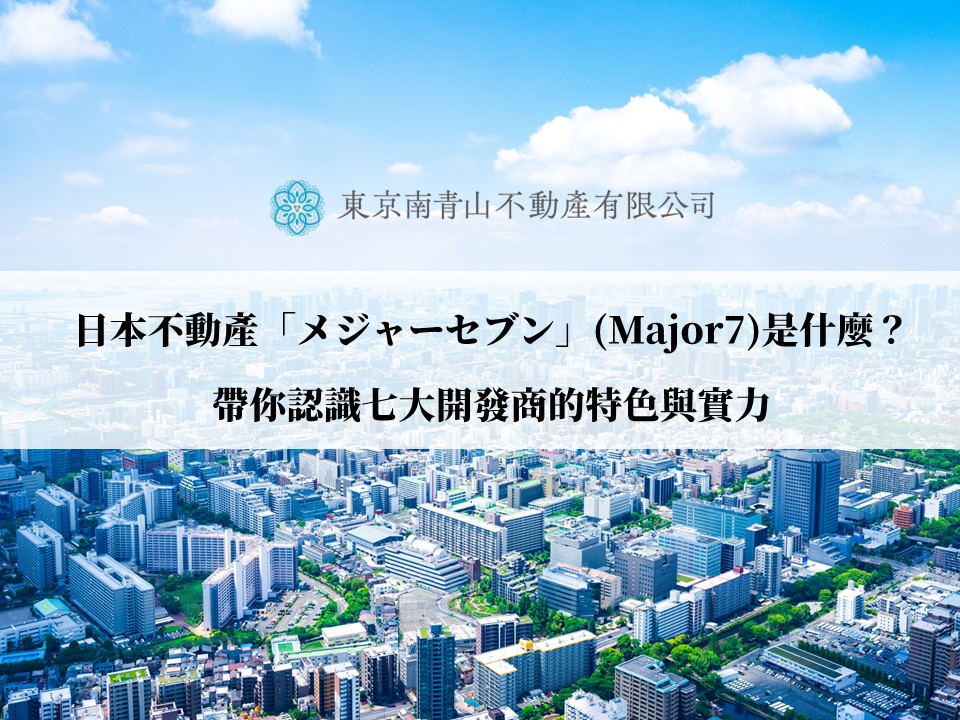Shimbashi Station was chosen as the site of Japanese first railway station (*) between Shimbashi to Yokohama. In the "SL Square" in front of the station, an SL (steam locomotive) is exhibited to commemorate the "starting point of the founding of the railway".
* Prior to the opening, the railway between Shinagawa to Yokohama has been temporarily operated first.
The area around Shimbashi Station is characterized by the blending of the bustle of the business district with deep cultural richness. Through Shimbashi Station, we will introduce all the charms of the station, from the cultural information to the sacred place that is recommended by office workers.
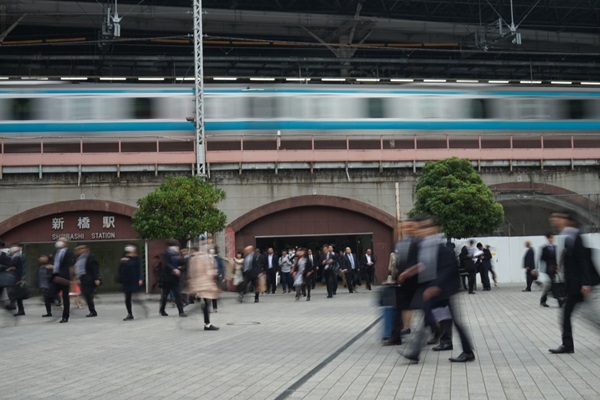
Basic information about Shimbashi Station, an area where many office workers gather
Shimbashi Station is in Shimbashi, Minato City, Tokyo, and the SL Square in front of the station is famous for being often used for street interviews such as wide shows. There are many office districts around the station, and there are also many taverns where you can easily quickly visit, so it is easy for office workers to gather. In addition, there are headquarters of TV stations, major advertising companies, etc.; thus, it is easy for media professionals to gather.
For this reason, Shimbashi is also famous for office workers. The area around Shimbashi Station gathers many long-established and well-known companies and is near business districts such as Uchisaicho, Toranomon, and Kasumigaseki.
Therefore, rental demand tends to be stable because it is an area where many office workers gather. Since major companies and media-related companies are gathering there, house demand for high-income earners is predictable.
According to the data on the number of passengers by station released by the Ministry of Land, Infrastructure, Transport and Tourism in 2022, the average number of passengers at Shimbashi Station in 2021 was 334,812 per day, making it the ninth-highest number of passenger capacity in Japan Railway.
Source: Ministry of Land, Infrastructure, Transport and Tourism National Land Numerical Information Download Site "Number of Passengers by Station Data"
Source: Statistical Information Research "Statistics on the number of passengers at Shimbashi Station (JR East Japan)"
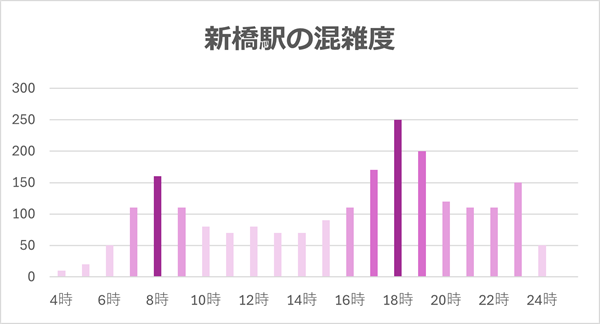
Crowd levels in Shimbashi Station per weekday is as follows.
* Created independently by processing from JR East Japan's official website " Station Crowding Situation" and NAVITIME "crowd predictor."
* Classified into four crowd levels according to the numbers on the vertical axis. Very crowded (200~250), crowded (150~200), not very crowded (100~150), vacant (0~100)
During the rush hour in the morning, Shimbashi Station tends to be less crowded than Tokyo Station and Shinagawa Station. It is conceivable that passenger will be distributed among those who commute to the area around Shimbashi Station to those who use Shiodome Station, Toranomon Station, Uchisaiwaicho Station, etc. Moreover, the reason the crowd level rises a little around 11 p.m.is because people who enjoyed the meals around Shimbashi Station tend to go home during that time to catch the last train.
Train Lines serve Shimbashi
Shimbashi Station is served by a total of seven train lines.
JR East Japan
● Tokaido Line
● Ueno Tokyo Line (Joban Line)
● Yamanote Line
● Yokosuka Line
● Keihin Tohoku Line / Negishi Line
subway
● Tokyo Metro Ginza Line
● Toei Asakusa Line
private railway
● Yurikamome
These lines provide straight access to Oshiage and Toyosu (Tokyo) in the east, Shibuya, and Shinjuku (Tokyo) in the west, Atami (Shizuoka Prefecture) in the south, and Utsunomiya (Tochigi Prefecture) and Takasaki (Gunma Prefecture) in the north.
If you are in Tokyo, you can reach Asakusa (Ginza Line), Odaiba, Tokyo Big Sight, Toyosu (Yurikamome), Kitasenju (Joban Line direct Tokaido Main Line), etc. directly from Shimbashi Station without transfer.
Within a 15-minute walk from Shimbashi Station are Kasumigaseki Station, Hibiya Station, Higashi-Ginza Station, Uchisaiwaicho Station, and Ginza Station. As a result, it is easy to use the Tokyo Metro Hibiya Line (direct Tobu Skytree Line), Marunouchi Line, and Toei Mita Line (direct Tokyu Meguro Line and Tokyu Shin-Yokohama Line).
Access to major stations and airports from Shimbashi Station
The ways to get to the major stations and airports from Shimbashi Station, and the time it required.
● Tokyo Station: 1 stop on the Ueno-Tokyo Line
● Shibuya Station: 7 stops on the Ginza Line
● Shinjuku Station: 12 stations on the Yamanote Line (clockwise)
● Ikebukuro Station: 14 stations on the Yamanote Line (counterclockwise)
● Shinagawa Station: 1 stop on the Ueno-Tokyo Line
● Ueno Station: 1 stop on the Ueno-Tokyo Line
● Haneda Airport (Terminal 2): 14 stops on the Keikyu Main Line direct Asakusa Line (toward Haneda Airport Terminal 1 and 2 stations)
● Narita Airport (Terminal 1): 19 stops on the Keisei Narita Sky Access Direct Asakusa Line (Narita Airport Direction/Access Limited Express)
Shimbashi Station is also close to Ueno and Shinagawa on the Yamanote Line, making it easy to reach. Since the Asakusa Line passes through Shimbashi Station, it is also accessible to Haneda Airport and Narita Airport.
Sightseeing spots that can be reached directly from Shimbashi Station
From Shimbashi Station, people can access the following areas without transfer.
Tokaido Main Line
● Atami
● Numazu
● Ito
● Utsunomiya
Yokosuka Line
● Kamakura
● Yokosuka
In addition, the proximity to Tokyo Station and Shinagawa Station makes it easy to access the Shinkansen, and it has direct access to Haneda Airport and Narita Airport, making it easy to reach various parts of Japan and overseas.
The area around Shimbashi Station, which merges the old-fashioned restaurant district and advanced buildings, is an area where everyone wants to live even foreigners
The atmosphere on both sides of JR Shimbashi Station is slightly different.
On the west side, there is an office district that leads to Kasumigaseki and Toranomon. Shimbashi Nishiguchi Street is a shopping street that has been popular for a long time just outside the Karasumori Exit. It is full of restaurants where people can easily quickly visit, and it is a livable area where many office workers live nearby. On the other hand, there are many supermarkets, drugstores, and a convenient living environment.
On the east side, Shiodome Sio-site is an advanced city that has been redeveloped from the site of the former Old Shimbashi Station. In addition to the headquarters buildings of major companies, TV stations, city hotels, etc., it is also a place where you can find residential and commercial facilities. During weekdays, many office workers pass through the office district, but at night and on weekends, the city is quiet.
As of January 2024, there are 21,278 foreigners living in Minato City and 10,370 foreigners living in Chuo City in the Shimbashi Station area (Source: Tokyo Metropolitan Government's statistics "Foreign Population by Nationality and Region by Municipality in Table 1 (Top 10 Countries and Regions).”
Shimbashi Station is close to the Tsukiji Outer Market and Kabuki-za theater, which are unique place to Japan's culture. Furthermore, it is close to Ginza, where high-brand shops popular with foreigners are located, so it is an area where foreigners would like to live.
The past and future of Shimbashi Station, the origin of Japan Railways
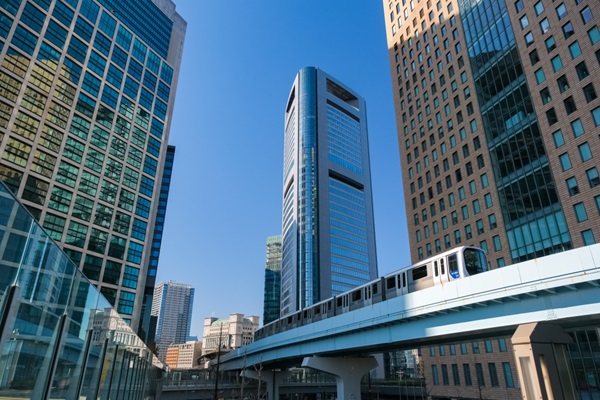
In 1872, Japan's first railway officially operated between Shimbashi to Yokohama, at that time, Shimbashi Station was established. The reason the first railway was connected from Shimbashi to Yokohama was because there were foreign settlements in Tsukiji and Yokohama, which were near to Shimbashi.
The first Shimbashi Station was originally planned to construct an elevated railway that would connect Shimbashi to Ueno Station from north to south. But there is one problem. The first Shimbashi Station had a dead-end structure, and because of the downtown area of Ginza on the north side, it was not possible to extend the railway through it. Therefore, apart from the first Shimbashi Station, a track leading to Ueno was built. That is Karasumori Station, which opened in 1909 - now Shimbashi Station.
In 1914, the original Shimbashi Station was renamed Shiodome Station and became a dedicated station for baggage and freight trains. At that time, Shiodome Freight Station was a place where goods were accumulated. Today, Shimbashi Station is an office district surrounded by modern buildings, and the location and appearance have changed. Moreover, it has now evolved into a terminal station that is served by multiple train lines such as the Yamanote Line and the Tokaido Line.
Shimbashi Station will continue to evolve steadily around new elements. In 2019, Minato City formulated the "Shimbashi-Toranomon District Community Development Guidelines" and decided to systematically promote community development around Shimbashi Station. These guidelines include the revitalization of alley spaces that are typical of Shimbashi, the inheritance of the cityscape, the creation of pedestrian-centered spaces, and the creation of spaces that support the promotion of innovation.
In addition, the two major buildings in front of Shimbashi Station, the Shimbashi Ekimae Building and the New Shimbashi Building, are being considered for redevelopment because it has been completed more than 50 years. These buildings are filled with many restaurants with a nostalgic Showa atmosphere and are characterized by many office workers coming and going on their way home from work, especially on weekdays. If it were to be demolished and rebuilt, the city would become more advanced.
In 2023, the wooden "Shimbashi Platform" will open in the Shimbashi area. People can go there for meetings, rest, and holding events. Shimbashi Platform utilizes the idle land in the redevelopment area. Moreover, we plan to reuse some of the wood used for new buildings in the redevelopment of the Shimbashi area to contribute to a sustainable society.
Through these initiatives, it is expected that the area around Shimbashi Station will become more convenient, and it will be reborn as an attractive city with a modern atmosphere.
spots where you can experience the Shimbashi Station area
There are many spots in the area around Shimbashi Station, some of them are historical, and others are novel and fashionable. Here are five recommended spots that are worth visiting.
Gourmet and relaxation spots where you can enjoy the unique atmosphere-"New Shimbashi Building"
The New Shimbashi Building, which stands in front of SL Plaza, is a large-scale tenant building with a history of more than 50 years. It is occupied by restaurants, grocery stores, cash ticket shops, and massage parlors. It is nicknamed the "Oyaji(uncle) Building" because it targets middle-aged and elderly office workers.
There are many restaurants where people can enjoy meals at reasonable prices, and it is often crowded with many people, especially office workers who live in the area, during lunchtime and the evening. "Cafe Fuji" located in the basement, established 30 years ago, is a shop where people can enjoy the taste of old-fashioned Neapolitan (Japanese pasta), shrimp pilaf, and hot cakes at a reasonable price.
New Shimbashi Building Official Website
Showa retro restaurants are lined up in the entertainment district-"Shimbashi Nishiguchi Street"
Shimbashi Nishiguchi Street, which is near Karasumori Exit, is a shopping street with many restaurants and an atmosphere reminiscent of the Showa era. Many people may deem that this is the entertainment district for office workers.
The crowds are especially active at night and on weekdays. Shimbashi Station is crowded with many people until around 11 p.m. before the last trains depart. Undoubtedly, it is an area where not only office workers but also residents can stop by.
Shimbashi West Exit Street Official Website
A shrine quietly nestled in the crowd which is famous for praying for entertainment and cancer healing-"Karasumori Shrine"
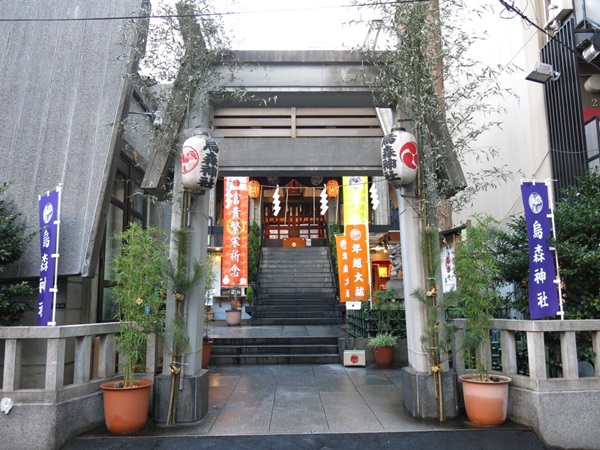
Karasumori Shrine was founded in 940 during the Heian period and sits in the center of Shimbashi. Although it is a small shrine, tourists visit it every day due to its popularity.
Karasumori shrine is famous for praying for entertainment and cancer healing, it is rare because most of the shrines are praying for business prosperity and family safety. The reason why it is beneficial to heal cancer is that during the Great Fire of Meireki (a great fire that burned down most of Edo) that occurred in 1657, only Karasumori Shrine escaped the spread of the fire, so it was said that it is effective of "contained disaster" which led to the benefit of healing cancer.
The area around Shimbashi Station, including Karasumori Shrine, was once called "Sakurada Village, Musashi no Kuni" and was a zone of sandy beaches and pine forests in Edo Bay. Therefore, this area was called "Karasu Forest" or "Kushu Forest" at that time. In addition, since many crows gathered in this pine forest, it is also called a "Crow Forest". This is the origin of the name of the shrine, "Karasumori (meaning the place where crows live).”
Karasumori Shrine holds an annual grand festival in early May with mikoshi (a portable mini shrine that houses a god) and festival floats. It is also famous for the appearance of a large mikoshi once every two years.
In addition, the design of the temple stamp will change with the seasons such as the New Year, Setsubun, and Hina matsuri, attracting fans of shrines and temple stamps.
Karasumori Shrine official website.
Although it is a TV station, the public can also visit the spot-" Nittele Tower"
Nittele Tower is a 32-floor skyscraper located in Shiodomeguchi. It is the headquarters of Nippon TV. Moreover, it is the first commercial television station in Japan, and it houses a studio that produces programs.
Originally, Nippon TV's head office was in Kojimachi, Chiyoda-ku, but in 2003 it moved to Nittele Tower to accommodate digital broadcasting. Incidentally, with this relocation, all key commercial broadcasting stations in Tokyo (Nippon TV, TBS, Fuji TV, TV Asahi, TV Tokyo) are in Minato City.
In addition to studios, Nittele Tower is a multipurpose hall. It has a public plaza, and a shop selling the goods of Nippon TV. It is a place not only to disseminate information but also a place of relaxation for residents.
Reproduction of the original Shimbashi Station! A spot where you can revisit the history-"Old Shimbashi Station"
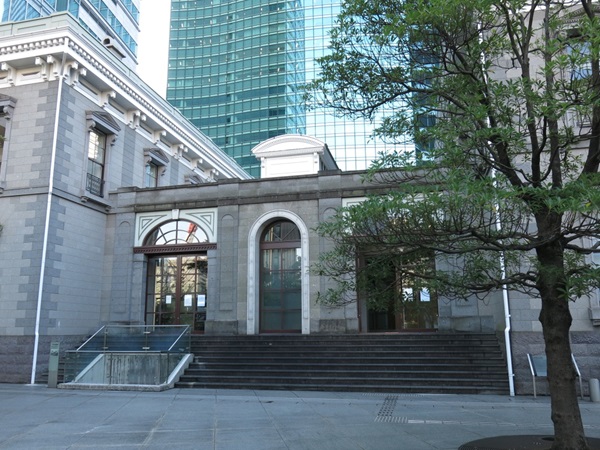
The original Shimbashi Station has been rebuilt in the same place as the "Old Shimbashi Station". In the 1990s excavations of buried cultural properties were conducted. At that time, the remains of the foundations and platforms of the Shimbashi Station were discovered.
The station building was destroyed by fire in the Great Kanto Earthquake. However, based on clear photographs of the discovered buildings, the original station building was restored to the same position as the original, and in 2003 it reopened as the "Old Shimbashi Station". Inside the station building, there is a free exhibition room where anyone can feel free to quickly visit. It is a spot where you can trace the long transition of Japan's railways, including the history of the area around the former Shimbashi Station, the place where Japan's railways first operated.
Old Shimbashi Station Official Website
Interesting trivia facts about Shimbashi Station
Shimbashi Station, a station with a long history, contains some interesting trivia facts that might surprise you.
Why Shimbashi Station (Shiodome) was chosen as the site of the first railway station
The reason Shiodome was chosen as the first railway station in Japan was that it had a large area of land to build a station and it was the site of the residences of three former feudal lords, including Sendai Domain, Tatsuno Domain, and Aizu Domain. Furthermore, Shiodome was a flat land, and it was adjacent to the center of Tokyo.
In addition, the Shiodome area gathered many populations from Ginza and Karasumori; thus, people believed Shiodome areas would attract more passengers.
Didn't the steam locomotive in SL Square arrive and depart from Shimbashi Station?!
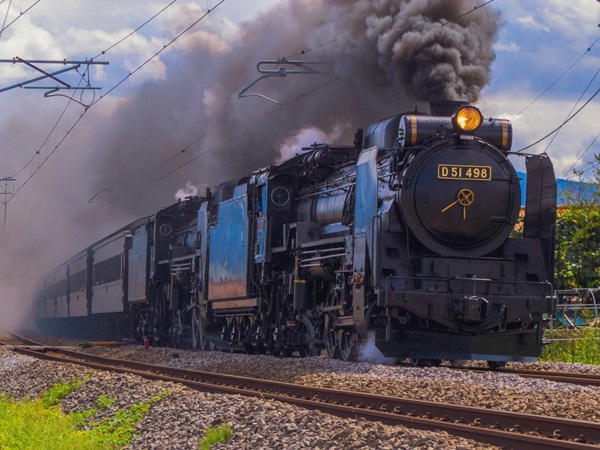
* Picture for illustration purposes only.
Displayed in the SL Square in front of Shimbashi Station is the "C11 Steam Locomotive". Surprisingly, this train has never departed or arrived at Shimbashi Station.
Originally, the C11 belonged to the Himeji Engine Depot (Hyogo Prefecture) and was active on the Chugoku region route. It was manufactured in 1945 by Japan Sharyo and served in the Himeji Engine Depot until its retirement.
In 1972, to commemorate the 100th anniversary of the opening of Japan's railways, authorities decided to exhibit C11 in front of the station since the C11 was in good condition. The C11 was retired in August 1972, and it was not until October of the same year that it began to be exhibited at Shimbashi Station. Surprisingly, the C11 itself would be exhibited in a place where it had never traveled before after its retirement.
Summary
Shimbashi Station is a place where history and modernity coexist. It is an area where shopping streets that retain the atmosphere of the Showa era and modern buildings are in lockstep. It is an area that is constantly evolving. The charm of the area will continue to grow.
If you are considering purchasing real estate around Shimbashi Station, please refer to the information provided in this article.






